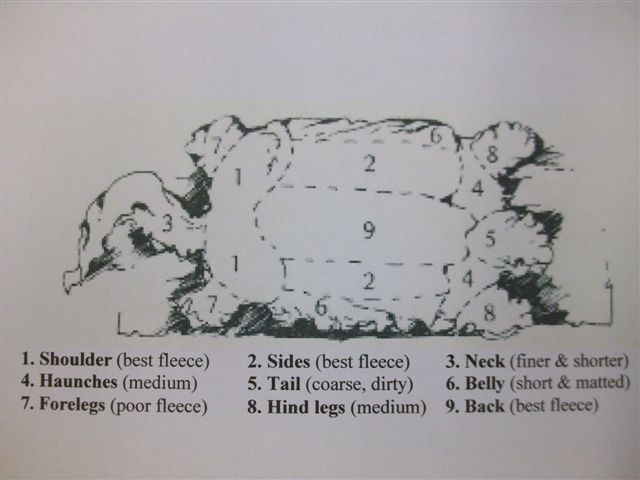Here at Rampisham Hill Farm we take pride in selling our own quality Dorset Down fleeces, to spinners and crafters all around the world.
Dorset Down Raw Fleece & Processed Fibre
Dorset Down wool is renowned for its use in the hosiery and fine tweed trade. Being very fine and versatile, like many Down breeds, it makes an excellent choice for the hand spinner.
Fleece weight: approximately 4-6 pounds, 2-3 kg
Staple length: usually 2-3 inches, 50-75 mm
Fibre diameter: about 25-30 microns
Crimp: usually distinct and even
Lustre: medium
Softness: very soft
Elasticity and Loft: superb
Colour: white, but can be fractionally creamier than the Poll Dorset
Dyeing: The fleece will take dying well
Comments: Often blended with other fleeces to give elasticity and crispness to the yarn
Suitable for: spinning, weaving, knitting, crocheting and needle felting. It does not easily wet felt

All our fleeces receive several initial sorts by hand before packing, so you won’t get a matted lump of belly wool or a load of dags contaminating the rest of the fleece.
DORSET DOWN EWE FLEECE – prime quality – £12.00 each
DORSET DOWN EWE FLEECE – second quality – £8.00 each
Raw fleece is priced per fleece including VAT – each fleece weighs approximately 2.5 kg raw.
We can post out to you in Mainland UK for:
£8.50 for a fleece, £10.50 for 2 fleeces or £15 for 3 – 5 fleeces.
If you would like to order Our Dorset Down Fibre please contact us.
WASHED & CARDED FLEECE – please contact us for the full range currently available direct from our own wool processing mill. www.rampishamhillmill.co.uk
Terms used to describe and choose fleeces:
CRIMP – the natural waves within the wool fibres
STAPLE LENGTH – the length of the individual fibres
LUSTRE – the ability of the wool to reflect light (shininess)
ELASTICITY / LOFT – the airiness and warmth of the fleece
LANOLIN – the natural oils excreted from the sheep
ROVING – washed and carded fleece ready to spin
SKIRT – the removal of undesirable parts of the fleece
SECOND CUTS – small fibres created when the shearer passes for the next cut
KEMP – coarse hollow fibres present in some breeds
SHEARLING FLEECE – a fleece from the first shear of a sheep, this makes the fleece purer and free from blemishes caused by lambing etc. It is often longer in staple length as well
EWE FLEECE – this is fleece from female sheep who have been shorn before, and probably had a lamb in the spring, it still makes fantastic wool, but won’t be as pure as the shearlings

Dorset Down
We do not use any products externally on our sheep so the raw fleeces are free from chemicals, and contain only natural lanolin greases.
PREPARING YOUR FLEECE
Although we do an initial hand sort of the fleece before you get it, the first thing to do is lay the fleece onto a clean surface and further sort it. Any vegetation matter or second cuts need discarding, before you group the similar areas of wool into batches for processing (see diagram in Hints, tips and information). Depending on what you are going to do, the usual next step is to wash the fleece.
There are two key things to remember when washing a fleece:
– Don’t stress it by going from hot to cold water temperatures, try to keep the water temperature as constant as possible.
– Don’t agitate it, let it soak. Agitating it will encourage the fibres to felt together.
To wash the fleece you need a tub or bath, and ideally some mesh laundry bags. The natural greases within the fleece melt at about 45-50 degrees Celsius. That equates roughly to water that is too hot to comfortably hold your hand in for any length of time.
The best detergent to use is a wool washing detergent: this is because they have a pH that will not damage the fibres (wool fibres do not like alkaline solutions).
Add detergent to your hot water to create a fairly strong concentration then put your fleece into the water and let it soak for about 10-15 minutes.
DO NOT AGITATE THE FLEECE.
Remove the wool and empty out the dirty water. Refill the tub / bath with clean water of the same hot temperature but this time not quite as much detergent. Place the fleece back into the water and leave to soak for another 10-15 minutes.
After that, repeat the process twice more but this time do not use detergent, as you want to rinse the fleece clear of any detergent residues.
Fleeces take a while to dry out and wool can hold 30% moisture content before it even feels damp, so it is important to gently spread your washed fleece onto an airing rack to allow it to properly dry out.
Once dry you are ready to commence preparation of your fleece to spin etc. If you haven’t washed a fleece before, there are a lot of different ways of doing it, and more information is available on the internet and in books, we always recommend trying a small bit first before you wash a whole fleece in one go.

